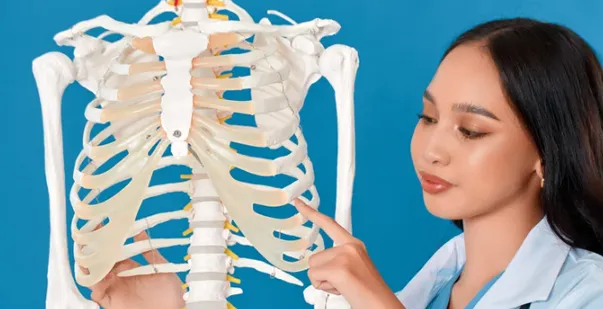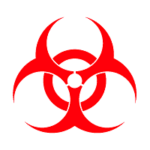If you ever had a rib fracture, you would know that this type of injury causes severe pain. Most importantly, pain from broken ribs can impact your breathing, which can even lead to a chest infection. Car accidents, sports injuries, or other traumas usually cause fractured ribs. However, it is also possible to break a rib without experiencing trauma. A few people can consult their regular doctor for a single broken rib. However, individuals with more complex fractures, symptoms, or injuries should seek immediate care at a trauma center. Let’s learn everything you need to know about rib fracture treatment, its causes and symptoms and even how to prevent broken ribs in the first place.
What is a Rib Fracture?
A rib fracture occurs when one or more ribs crack or break, often due to trauma like car accidents or falls. People with osteoporosis or weakened bones also have an increased risk of these fractures. Athletes who play contact sports may also have a higher chance of breaking a rib compared to other people.
You rarely need surgery to repair your fracture unless the injury that broke the rib damaged your internal organs. However, a few fractures can have life-threatening complications. Thus, you must visit a healthcare provider if you experience symptoms like pain and tenderness around your ribs and chest.
Numerous fractured rib patterns exist, but the most common ones include stress fracture, avulsion fracture, comminuted fracture, and floating fracture.
6 Common Causes of Rib Fracture
Humans have 12 pairs of ribs that wrap around the chest. You can get a fractured rib when something hits your chest. This can occur usually in the form of blunt force trauma that can be a result of several incidents. The most common causes include:
In car accidents, the force of the crash can slam the chest against the steering wheel or other parts of the vehicle. This can cause ribs to break due to the sudden and intense pressure on the body.
Falling from a height, such as off a ladder or during a slip, can cause a hard landing on the chest or side, which might lead to fractures from the impact on the ground.
In contact sports like football or hockey, a direct blow to the chest from another player or equipment can fracture a rib, especially when the impact is sudden and powerful.
During a physical altercation, a punch or kick to the chest can cause enough force to break one or more ribs. This occurs particularly when the blow is delivered with significant pressure and strikes a vulnerable area of the ribcage.
- Cancers That Have Spread to Bones
Certain cancers like breast or lung cancer can spread to the bones and weaken the ribs. As a result, bones become more likely to fracture, even with mild pressure or minor trauma to the chest.
A severe, persistent cough can repeatedly strain the ribs, potentially causing small fractures. This occurs especially in people with weakened bones, such as those suffering from osteoporosis.
How Do You Identify a Rib Fracture?
A broken rib can cause severe pain and may require medical attention in some cases. That is why you should look out for some signs and symptoms associated with fractured ribs. The most common rib fracture symptoms include:
One of the most noticeable symptoms of this fracture is sharp or stabbing pain in the chest area, especially when you move, breathe, or cough. The pain may worsen with certain activities or when pressure is applied to the injured area.
- Bruising or Swelling Around the Ribs
After a fracture, you may notice bruising or swelling around the affected rib. This happens as blood and fluid accumulate in the area due to the injury, which can lead to visible discoloration or puffiness.
The fractures can make it difficult to take a deep breath, leading to a sensation of shortness of breath. This happens because the ribs may not expand properly, and deep breathing can cause discomfort.
- Difficulty Taking a Deep Breath
Taking a full, deep breath can be painful with a fracture. This difficulty may arise due to the sharp pain experienced during inhalation, which can limit lung expansion and oxygen intake.
What Complications Are Associated With Rib Fractures?
A broken rib can often cause damage to your blood vessels and internal organs. The likelihood of these sufferings happening is higher if you have multiple fractured ribs. The complications associated with fractures can be many, which include:
- Breathing Issues: A fractured rib can make it difficult to take a deep breath. Pain and discomfort can lead to shallow breathing, which increases the risk of lung infections like pneumonia.
- Flail Chest: If multiple ribs break in more than one place, a part of the chest wall may move independently, called “flail chest.” This can interfere with normal breathing and cause severe pain.
- Respiratory Failure: In severe cases, fractures on the rib can lead to respiratory failure. This happens when the lungs cannot provide enough oxygen to the body due to damage.
- Pulmonary Contusion: The fracture can cause bruising of the lung tissue, known as pulmonary contusion. This leads to difficulty breathing and reduced oxygen levels in the blood.
- Hypoventilation: This condition occurs when shallow breathing reduces airflow to the lungs. If left untreated, it can cause lower oxygen levels and lead to complications.
- Hypercapnia: This occurs when there is too much carbon dioxide in the bloodstream. It can result from slow or shallow breathing, which is common with these fractures.
- Hypoxia: This condition occurs when the body does not get enough oxygen, often caused by difficulty breathing due to rib injuries.
- Atelectasis: Atelectasis is the partial collapse of a lung, which may happen if deep breathing is too painful, restricting airflow and oxygen intake.
- Hemothorax: This is a condition in which blood accumulates in the space between the chest wall and lungs, usually due to damage from a broken rib. It can lead to severe difficulty breathing and requires immediate medical attention.
- Injury to the Lung: A sharp end of a broken rib can puncture the lung, leading to a collapsed lung (pneumothorax). This results in severe chest pain and shortness of breath.
- Ruptured Blood Vessel: In rare cases, a fractured rib can puncture a major blood vessel, like the aorta. This can cause severe internal bleeding and is a life-threatening emergency.
- Injury to the Liver or Kidneys: The lowest two ribs protect the liver and kidneys. If these ribs break, they can cause serious damage to these vital organs, which can lead to internal bleeding and other complications.
What Diagnostic Techniques Are Used for Rib Fractures?
A healthcare provider usually diagnoses a rib fracture with a physical exam. A few of them might use imaging tests to check for damage to your internal organs. These include the following:
X-rays are the primary imaging test used to diagnose rib fractures. They provide a clear image of the bones. They allow doctors to see if a rib is broken and the extent of the fracture.
X-rays can also help detect complications, such as a punctured lung or damage to surrounding tissues. They are non-invasive and are typically the first step in assessing rib injuries.
- Magnetic Resonance Imaging (MRI)
MRI enables your healthcare provider to get a complete picture of the damage to your bones and the area around them. It also shows images of the tissues around your bones. This helps determine if your muscles, connective tissue, or organs are injured, too.
A CT scan gives a more detailed picture of your bones and the surrounding tissue than an X-ray. A healthcare provider runs a CT scan if X-rays are inconclusive. They may also conduct the scan if you need surgery.
Ultrasound can also be used to detect rib fractures, especially when X-rays are not sufficient or when there is a concern about soft tissue injuries. This technique uses sound waves to create images of the chest area. While it’s not as effective as X-rays for seeing bone fractures, ultrasound can be particularly useful for detecting damage to soft tissues or internal organs, such as a lung contusion or hemothorax.
Read More: 7 Must-Have Medical Supplies for Your Travel First Aid Kit
How Doctors Treat Rib Fractures?
A broken rib treatment often depends on the severity of the injury. Your broken bones must heal back together. You might also have to stay in the hospital if any of your organs were damaged during the trauma. Bruised rib treatment is possible with rest, icing, and over-the-counter (OTC) medications. Your healthcare provider will inform you how often to apply ice. However, it is usually recommended to apply ice to your ribs for over 20 minutes a few times a day.
You may also have to do some breathing exercises or cough on purpose every few hours while you recover from fractured ribs. This enables you to prevent pneumonia and keeps your lungs and chest moving like usual. You may also try pressing a pillow to your injured ribs to help cushion any pain during your breathing exercises. Additional treatment options for broken ribs include the following:
- Internal Fixation
The most serious rib fractures require surgery. Your surgeon will set your bones to their correct position as a part of this procedure. Then, the surgeon will secure the bones in place so they can heal and grow back together. They usually perform a process called internal fixation, which involves inserting pieces of metal into the bones. You may also have to limit how much you use the surgically repaired part of your body during the healing process.
Internal fixation techniques usually include:
- Plates and screws are attached to your bone to hold the pieces together and in place.
- Pins and wires that hold different bone pieces in place that are too small for other fasteners.
A few people live with these wired pieces inserted in them forever. Also, anyone who wants to remove them must go for follow-up surgeries.
- Bone Grafting
This procedure is necessary if your rib fracture is severely displaced. This also applies if your bone isn’t healing the way it should. Your surgeon will insert an additional bone tissue to rejoin your fractured bone in the ribs. This is usually followed by internal fixation to hold the pieces together while your bones regrow over time. Bone grafts come from a few sources:
- The top of your hip bone
- An external donor
- An artificial replacement piece
Recovery Time for Broken Ribs
Treatment for bruised ribs takes time. Previously, healthcare professionals thought that the pain and symptoms of broken ribs lasted no more than 6 to 8 weeks. However, research suggests that many people experience pain for longer periods.
If you have a simple fracture, you can recover at home. However, in more serious cases, you may need to stay in the hospital. During the healing process, healthcare professionals recommend rib fracture medication to reduce pain.
Self-Care for Broken Ribs
Self-care is the most important aspect for a quick recovery from th injury or surgery performed to treat broken ribs. Following are a few self-care tips for broken ribs:
- You can apply ice to decrease swelling and pain, which helps prevent tissue damage. Before placing an ice pack or bag of crushed ice on your injured area, make sure to cover it with a towel.
- Sometimes, a few rib fractures can also lead to lung infections. Your healthcare provider may recommend trying deep breathing exercises to prevent these infections. The process involves taking a deep breath and holding it for as long as possible. Then, you must let out the air and cough strongly.
- When coughing hurts, you can try supporting the rib area with your hands, a towel, or a pillow while performing the exercise.
Please note that if you have broken ribs, you should not participate in contact sports for at least six weeks.
Read More: Recumbent Position: What Is It, Variations, and More
Understanding Rib Fractures for a Healthier Life!
A rib fracture may range from a small crack caused by a cough to a severe injury after trauma. The most important thing to do here is to get your ribs examined by a healthcare provider. You must contact your healthcare provider about broken ribs as soon as you notice any pain in your chest or have trouble breathing.
This also involves getting regular bone density screenings if you are older than 50 or have a family history of osteoporosis. You must always approach a healthcare professional with efficient CPR training in treating fractures. Make sure to get adequate rest and ice your affected area if needed.






